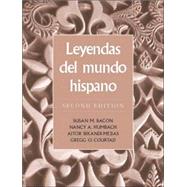
| La Casa de los Muñecos (México) | |
| El Dorado (Colombia) | |
| La leyenda de los cadejos (El Salvador) | |
| Los amantes de Teruel (España) | |
| Los novios (México) | |
| Las once mil várgenes (Puerto Rico) | |
| La leyenda de la yerba mate (Argentina/Paraguay) | |
| El ñandutá (Paraguay) | |
| La Llorona (México: versión colonial) | |
| La Llorona (Estados Unidos: versión moderna) | |
| Glosario español/inglés | |
| Glosario inglés/español | |
| Table of Contents provided by Publisher. All Rights Reserved. |
The New copy of this book will include any supplemental materials advertised. Please check the title of the book to determine if it should include any access cards, study guides, lab manuals, CDs, etc.
The Used, Rental and eBook copies of this book are not guaranteed to include any supplemental materials. Typically, only the book itself is included. This is true even if the title states it includes any access cards, study guides, lab manuals, CDs, etc.